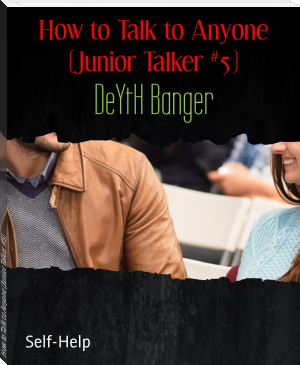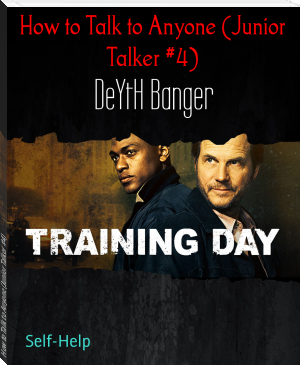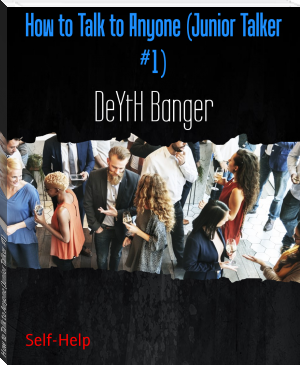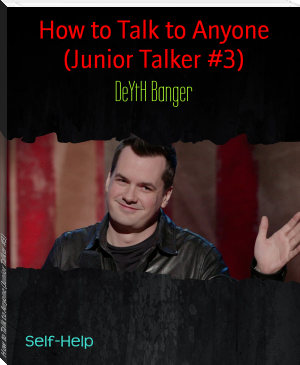How to Talk to Anyone (Junior Talker #5) by DeYtH Banger (old books to read .TXT) 📕

- Author: DeYtH Banger
Book online «How to Talk to Anyone (Junior Talker #5) by DeYtH Banger (old books to read .TXT) 📕». Author DeYtH Banger
However, as Gibson and Sachau note, sandbagging can be used in situations involving evaluation rather than competition. A student who’s actually studied hard tells a professor not to expect much out of the upcoming exam performance. By reducing expectations, the individual either looks better after succeeding at the task or has a reason to explain low performance, should that be the outcome. People can also reduce the pressure on them if they predict poor performance to others, because they’ve now got nothing to lose should this occur.
Barnett et al., examining the relationship between narcissism and sandbagging, used the 12-item Sandbagging Scale developed in that 2000 study by Gibson and Sachau. The North Texas researchers note that people use this strategy primarily as a way of protecting their self-esteem, as shown in previous research establishing a relationship between low self-esteem and sandbagging. People high in narcissism, the researchers maintain, are attempting to protect a fragile self-esteem reflected in feelings of vulnerability that they may cover up with grandiosity. As they note, “the high explicit self-esteem observed in narcissists is an attempt to cover up underlying low self-esteem and vulnerability” (p. 2). Not all psychologists agree that vulnerability and grandiosity are two sides of the same narcissistic coin, but for the purpose of studying sandbagging, such an assumption seems warranted. Going back to the theories of Adler and Horney, downplaying their abilities is a tactic that narcissists use to guarantee that they can’t fail, suggesting that their self-esteem indeed has a precarious basis.
The Barnett et al. findings supported the roles of both grandiose and vulnerable narcissism in explaining scores on the sandbagging measure above and beyond the effects of self-esteem. Thus, people high in narcissism attempt to look good by predicting bad. They use sandbagging, the authors conclude “to resolve the dissonance that stems from viewing themselves as superior yet potentially being negatively evaluated” (p. 5). This helps them manage their self-esteem by pretending that nothing’s at stake should they either succeed or fail.
Before examining the implications of these findings, let’s turn next to the Sandbagging Scale. If Barnett and his collaborators are correct, the items on this scale should provide a novel way to test people’s levels of narcissism, because those high in narcissism should score high on this measure.
To test yourself, indicate your agreement with these items on a 6-point scale from disagree very much to agree very much:
1. It’s better for people to expect less of you even if you know you can perform well.
2. The less others expect of me, the better I like it.
3. If I tell others my true ability, I feel added pressure to perform well.
4. The less others expect of me, the more comfortable I feel.
5. I may understate my abilities to take some of the pressure off.
6. When someone has high expectations of me, I feel uncomfortable.
7. I try to perform above others’ expectations.
8. It’s important that I surpass people’s expectations for my performance.
9. I like others to be surprised by my performance.
10. I enjoy seeing others surprised by my abilities.
11. I will understate my abilities in front of my opponent(s).
12. I understate my skills, ability, or knowledge.
In looking at your responses, flip your ratings of 7 and 8, which are the opposite of sandbagging. The 12 items divide into three sub-scales: Pressure (1-6), Exceeding Expectations (7-10), and Behavior (11 and 12). The average scores were in the higher end of the 6-point scale, with most people scoring between about 3 and 5, but the highest scores were in items 7-10, the Exceeding Expectations scale. It appears, then, that most people engage in some management of their self-esteem through sandbagging. As indicated by Barnett and his coauthors, those people who are highest in narcissism should be particularly likely to do so.
Hearing an individual expressing false modesty about an upcoming evaluation, as the Sandbagging Scale would seem to reflect, can provide you with cues that the individual is trying to protect a fragile sense of self. Rather than project an outward show of bravado, then, people high in narcissism can use the reverse strategy. The audience might be fooled by all of this down-regulation of expectations and not recognize that they are actually watching the self-preservation tactics of the narcissist.
To sum up, be on the lookout for sandbagging when you suspect that you’re witnessing false modesty. Fulfillment in life comes from being able to engage in situations involving competition or evaluation with a reasonable sense of inner self-confidence. People high in narcissism view every evaluative situation as a threat to their own fallibility, and as a result, cannot experience this sense of fulfillment.
Comedy and Mental Illness
Is bipolar disease funny? How about thoughts of suicide or obsessive worries of harming others?
Mental illness typically is not considered a topic that is funny. Certainly people who have a mental illness have been victims of ridicule or the butt of jokes, but can talking about mental illness be funny? And can it be done without demeaning or negatively targeting people who suffer with a mental illness?
Mental illness plays a central role in comedy for comedian Maria Bamford. She is diagnosed with bipolar disorder, obsessive-compulsive disorder (OCD) and has a history of suicidal thoughts.
She’s has several comic CD’s, performs live stand-up and has been praised by stars, such as Judd Apatow. And what makes her comedy so powerful and, yes, funny, is that she doesn’t skirt or apologize for they symptoms of her mental illness.
Her humor is self-deprecating, but not self-demeaning. Through comedy she explores her real life struggles with depression, anxiety and OCD. She was named one of the years 50 funniest people by Rolling Stone Magazine in part for a bit in which she imagines what it would be like if people dismissed physical illness in the same way that they do mental illness.
Bamford, of course, is not the only comedian who is diagnosed with a mental illness and who uses it in her routine. Comedian Joshua Walters, who has bipolar disease, explores creativity and mental illness in his comedy. As a co-founder of the Depression Bipolar Support Alliance Young Adults chapter in San Francisco, Walters has developed humor as a way to address the topic of mental illness and reframe it as positive.
“Everyone is just a little bit mad,” says Walters. “How much depends on where you fall in the spectrum. How much depends on how lucky you are.”
The combination of comedy and mental illness may not be so controversial as it sounds at first. Instability can make for great comedy. And audiences often can relate to a comic’s vulnerabilities when they are up on stage.
Comic Eddie Pepitone, who suffered a nervous breakdown at age thirty-five, panic attacks and claustrophobia says comedy can help you get through some of the toughest symptoms of a mental illness.
On the podcast, Mental Illness Happy Hour, Paul Gilmartin interviews comedians, as well as friends, artists and doctors about mental illness, trauma, addiction and negative thinking. He talks with people such as Chris Hardwick, a podcaster, comic and writer about his history of panic attacks, drinking issues and middle-school humiliations and Kerri Kenney-Silver, comedienne, actress and musician, about her history of substance abuse.
When it’s done well, as it is by many of the comedians mentioned above and many more who are unmentioned, comedy about mental illness can create a space for us to laugh and let down our guard in a safe environment. When we do this, we just might find that barriers and stigma also relent, maybe just a bit or just for a moment, while we laugh.
Chapter 9.1 - Not Funny Enough (Part 2)
Believe me... if I am telling you that you gonna die... it's not false evidence it's just a itchy bitch right in your butt hole.
Comedians and Mental Illness
Source
Not all great comedians derive their skill from personal pain but many do. Russell Brand was molested at the age of seven, became bulimic at 14, left home at 16 and began taking drugs.
Art Buchwald lost his mother to mental illness as a child and was raised in seven foster homes. Bill Cosby had an alcoholic, neglectful, and abusive father. There are many others with equally miserable backgrounds who take to the stand-up circuits.
In her 2011 book, Humor’s Hidden Power: Weapon, Shield and Psychological Salve, Nichole Force writes that “The comedian’s sensitivity to their own pain makes them especially sensitive to the pain of others; and the relief of that pain in others helps to relieve their own pain. In this way, bringing their audience joy literally brings them joy.”
Robin Williams
The rapid-fire improvisational genius went silent in August 2014.
There were no horrific stories of abuse and deprivation in Robin Williams’s background. He grew up in an affluent household; his father was a senior executive with the Ford Motor Company. His education was conventional and he was a classically trained actor.
He became hugely successful after his television debut as an alien in the 1970s hit Mork & Mindy.
However, mental illness is no respecter of talent and good fortune; psychiatric problems dogged Williams for most of his life. According to Julie Cerel, a psychologist and board chair of the American Association of Suicidology, Williams was known to have bipolar disorder and severe depression.
Source
As with many people suffering from these ailments, Williams turned to self-medication. He became addicted to cocaine and alcohol and sought treatment for both problems.
He went on drug binges with his friend and fellow comedian John Belushi. When Belushi died of a drug overdose in 1982, Robin Williams quit the habit. Of Belushi’s death he said “Was it a wake-up call? Oh yeah, on a huge level. The grand jury helped too.”
He also quipped that “Cocaine is God’s way of telling you that you make too much money.”
Twenty years later, he started drinking again and checked himself into a rehabilitation centre.
Following his death his publicist, Mara Buxbaum, said “He has been battling severe depression of late.” But Robin Williams knew as well as anybody how people with mental health issues try to conceal them: “All it takes,” he said, “is a beautiful fake smile to hide an injured soul and they will never notice how broken you really are.”
Robin Williams in a Manic PhaseYou opted out of youtubeRichard Pryor
Jerry Seinfeld called him “the Picasso of our profession.”
Richard Pryor’s mother was a prostitute, his father was a pimp, and he was raised in a brothel in Peoria, Illinois. He was sexually abused as a child and regularly beaten by his violent grandmother. It was the sort of upbringing that pretty much guaranteed a life of bad choices and incarceration, but it didn’t work out that way for Pryor.
He began performing in school, usually as the class clown. By the early 1960s he was working in African-American clubs in the mid-west, honing the craft that would later make him a massively popular entertainer.
By the mid-1960s he was making guest appearances on top television shows, performing a gentle, observations-on-life humour in the styles of Bill Cosby and Dick Gregory.
Source
In the late 1960s, he developed his own





Comments (0)